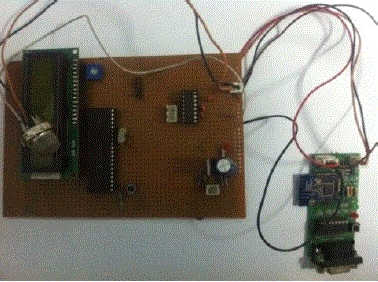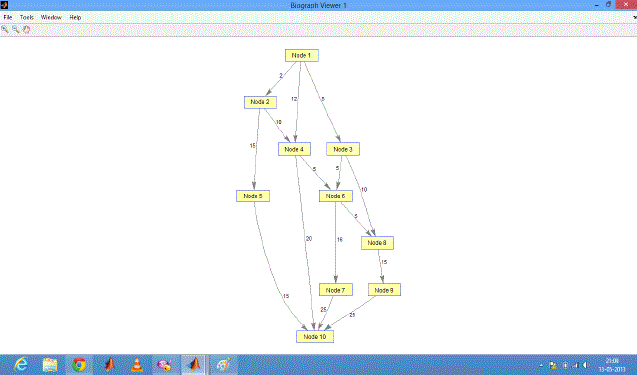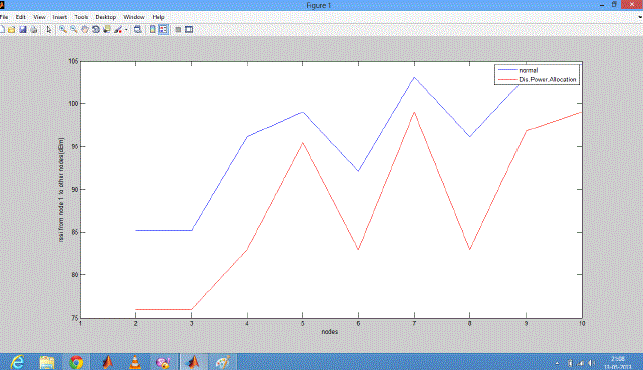Keywords
|
Routing protocol, Discrete radio power allocation, Received signal strength, wireless sensor
node, Energy efficient |
INTRODUCTION
|
A wireless sensor network essentially consists of thousands of standalone nodes which are battery operated and
remotely active. They are programmed in such a way as to monitor parameters and report anomalies or simply act as
transceivers over long distances depending on the application they are used for. So practically speaking all those nodes
are active at any given point of time and relaying information across the network. Wireless sensor networks have many
applications, such as military, homeland security, environment, agriculture, manufacturing, and so on. Routing is an
essential operation in such a networks. Prolonged network lifetime, scalability and information security are important
requirements for many wireless sensor network applications. In most of the research paper, the routing algorithms are
based upon software by which the energy consumption was made. But in this paper using the hardware, the energy
consumption was reduced, by which efficiency of the system was improved. Generally in wireless transmission the
transmission power is sufficiently made high so that the receiver somehow gets a signal. But there are various other
factors to be taken into account like the medium and other entities along the transmission path. the RSSI value as a direct
measure of the distance between the nodes. Using the RSSI value the cost estimation of each node is estimated
[1,6,7]. |
ZigBee is a specification for a suite of high level communication protocols using small, low-power digital radios
based on an IEEE 802 standard for personal area networks. ZigBee devices are often used in mesh network form
to transmit data over longer distances, passing data through intermediate devices to reach more distant ones. This allows
ZigBee networks to be formed ad-hoc, with no centralized control or high-power transmitter/receiver able to
reach all of the devices. Any ZigBee device can be tasked with running the network.ZigBee is targeted at applications that require a low data rate, long battery life, and secure networking. ZigBee
has a defined rate of 250 kbit/s, best suited for periodic or intermittent data or a single signal transmission from a sensor
or input device. RSSI and LQI are measured on the receiver node when a packet is received from the transmitter node.
As the distance increases, there are more chances for the packet to get lost and hence the RSSI decreases.The LQI
(Line Quality Index) is obtained to be a standard value of 108 in case of obstructionless paths. But when we have obstructions
the LQI decreases. The algorithm used is based on the concept energy conservation. Now that each Zigbee is
characterized by different power levels,we plan to assign the power level to be used wisely so as to reduce energy consumption.
We make use of the concept of discrete power levels such that we assign the same cost for nodes at different distances accordingly depending upon power levels. |
WIRELESS SENSOR NETWORKS
|
A wireless sensor network (WSN) is built of "nodes" – from a few to several hundreds or even thousands,
where each node is connected to one (or sometimes several) sensors. Each such sensor network node has typically several
parts: a radio transceiver with an internal antenna or connection to an external antenna, a microcontroller, an electronic
circuit for interfacing with the sensors and an energy source, usually a battery or an embedded form of energy
harvesting. Size and cost constraints on sensor nodes result in corresponding constraints on resources such as energy,
memory, computational speed and communications bandwidth. The topology of the WSNs can vary from a simple star
network to an advanced multi-hop wireless mesh network. The propagation technique between the hops of the network
can be routing or flooding. |
The sensor node is given in figure.1. Sensor node uses PIC Microcontroller, which was operated in deep sleep
mode by which energy saving was carried out when sensor node not receiving any data. For wireless communication,
Zigbee was used.Wireless Sensor networks have varied applications these days. They are used in various fields like defence,
healthcare and so on. Thus they provide good scope for improvement, because of their extensive usage. Power consumption
is the Achilles heel of Wireless Sensor Networks. |
MICROCONTROLLER PIC 16877A
|
Microcontroller PIC16F877A is one among a family of PIC microcontroller. They are popular in use today, ranging
from beginners to professionals. This is because it is very practical and uses PIC16F877A FLASH memory technology
that can erase the program, a thousand times. The excellence of RISC microcontroller lies in the speed and
compression code. In addition, PIC116F877A also quite practical and concise as it has 40-pin to 33 lines I / O. |
ZIGBEE
|
ZigBee is a low-cost, low-power, wireless mesh network standard. The low cost allows the technology to be widely
deployed in wireless control and monitoring applications. Low power-usage allows longer life with smaller batteries.
Mesh networking provides high reliability and more extensive range. |
ZigBee is a specification for a suite of high level communication protocols using small, low-power digital radios
based on an IEEE 802. standard for personal area networks. ZigBee devices are often used in mesh network form
to transmit data over longer distances, passing data through intermediate devices to reach more distant ones. This al lows ZigBee networks to be formed ad-hoc, with no centralized control or high-power transmitter/receiver able to
reach all of the devices. Any ZigBee device can be tasked with running the network. |
ZigBee is targeted at applications that require a low data rate, long battery life, and secure networking. ZigBee
has a defined rate of 250 kbit/s, best suited for periodic or intermittent data or a single signal transmission from a sensor
or input device. |
EXPERIMENT
|
RSSI and LQI are measured on the receiver node when a packet is transmitted from the transmitter node. As the
distance increases, there are more chances for the packet to get lost and hence the RSSI decreases.The LQI (Link Quality
Indicator) is obtained to be a standard value of 108 in case of obstruction less paths. But when we have obstructions
the LQI decreases. The algorithm used is based on the concept energy conservation. Now that each Zigbee is characterized
by different power levels, we plan to assign the power level to be used wisely so as to reduce energy consumption.
We make use of the concept of discrete power levels such that we assign the same cost for nodes at different distances
accordingly depending upon power levels. |
The procedure used for this experiment was to place the transmitter and receiver motes a starting distance apart
such as five meters. Then 10 packets are sent from the transmitter to the receiver with each power level setting available.
Once all the power level settings were tested, the receiver mote was moved The Two nodes are used practically
and RSSI, LQI values for different distances are estimated. Ten nodes are chosen and depending on the RSSI value ,
the cost are estimated. Using MATLAB Programming, the shortest path was carried out from one node to another
node. Depending on the discrete power allocation , the cost is assigned and the same routing algorithm is used . |
From the results, it can be proved that , the routing algorithm based on discrete power allocation is more energy
efficient. RSSI and LQI are measured on the receiver node when a packet is received. from the transmitter node. As the
distance increases, there are more chances for the packet to get lost and hence the RSSI decreases.The LQI (Line Quality
Index) is obtained to be a standard value of 108 in case of obstruction less paths. But when we have obstructions the
LQI decreases. The algorithm used is based on the concept energy conservation. Now that each Zigbee is characterized
by different power levels, we plan to assign the power level to be used wisely so as to reduce energy consumption. We
make use of the concept of discrete power levels such that we assign the same cost for nodes at different distances . |
In this paper , the various power modes of Zigbee is used, depending upon that the cost calculations was carried
out. In order to implement the work, 10 nodes are taken with different locations. Instead of providing same power
for all the nodes, different power levels setting are done depending upon the distance. The ZIGBEE has two modes of
operation viz. Command mode and Transceiver mode. The command mode is
used for performing special functions with the ZIGBEE like acquiring signal strength etc. The transceiver mode is used
for transmission and reception of signal. |
EXPERIMENTAL RESULTS
|
From the graph, it can be proved that RSSI value without discrete power levels was more. This implies, the efficiency
of the routing algorithms by taking discrete power level is more compared to the normal method, where the
power consumption is varied depending upon the distance. |
The Shortest Path algorithm was carried for 10 nodes, and the readings are noted. The Matlab Program are written
depending on the structure given above for both cases. From the tabulation , it can identified discrete level was better
than the normal. |
Figures at a glance
|
 |
 |
 |
| Figure 1 |
Figure 2 |
Figure 3 |
|
| |
References
|
- Michael Mallinson, Patrick Drane and SajidHussain, " Discrete Radio Power LevelConsumption Model inWireless Sensor Networks", IEEE 2007.
- Qing Cao, TianHe , Lei Fang, TarekAbdelzahe, John Stankovic and Sang Son," EfficiencyCentric Communication Model for Wireless Sensor Networks".
- Alberto Cerpa, Jennifer L. Wong, LouaneKuang, MiodragPotkonjak and DeborahEstrin ," Statistical Model of Lossy Links in Wireless Sensor Networks".
- Marco Zuniga and BhaskarKrishnamachari, "Analyzing the Transitional Region in LowPower Wireless Links".
- Wendi RabinerHeinzelman, AnanthaChandrakasan, and HariBalakrishnan. “Energy-Efficient Communication Protocol for Wireless Microsensor Networks”, 33rd Hawaii International Conference on System Sciences, 2000.
- Stephanie Lindsey, Cauligi S. Raghavendra. “PEGASIS: Power-Efficient Gathering in Sensor Information Systems”. Proceedings of IEEE AerospaceConference, pp. 1125-1130, Mar. 2002.
- S. Lindsey, and C. S. Raghavendra, and K. Sivalingam, “Data Gathering in Sensor Networks using the Energy*Delay Metric,”Proceedings of the 15th International Conference on Parallel and Distributed Processing Symposium, pp. 2001-2008, Apr. 2001
- R. Ramanathan, and R. Hain, “Topology Control of Multihop Wireless Networks using Transmit Power Adjustment,” Proceedings of the 19thIEEE International Conference on Computer Communication, pp. 404-413, Mar. 2000.
- L. Klein, Sensor and Data Fusion Concepts and Applications, SPIE-The International Society for Optical Engineering, Press, 1993.
|